It can’t be easy moving into any executive role when you’re replacing a hard-nosed, high profile performer with a stellar record for success. Even tougher, perhaps, when your natural character is somewhat more subtle. Such was the early challenge facing Isuzu Australia chief Andrew Harbison. But beware! Behind the mild-manner exterior lurks a shrewd, highly driven individual with no doubts about where Isuzu needs to be. At the top!
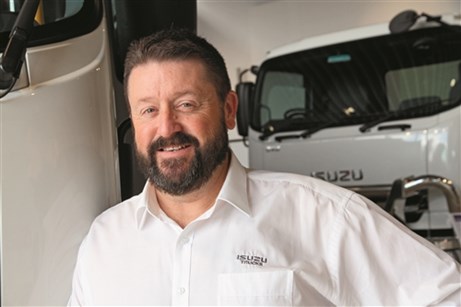 |
|
Isuzu Australia director and chief operating officer Andrew Harbison
|
It was maybe five or six years ago. Nah, probably more. Then again, perhaps not.
Whatever, it’s hard to keep track, especially when trying to recall a particular Isuzu drive event. There have been so many over so many years and let’s face it, a few hours at the wheel of a white Japanese truck rarely lends itself to the creation of a rock carving in the cranial cavern. Occasionally, but not often.
So let’s just say that once upon a time at one of these events somewhere, a memorable conversation at least took place. I had the wheel, Phil Taylor had his feet up.
For those who never had the pleasure, Taylor was a relentlessly fierce force in maintaining Isuzu’s Herculean domination of the Australian truck market before retiring early last year as director and chief executive officer of Isuzu Australia Ltd.
Over a lot of years and in spite of a few indelible, sharply debated differences on some issues, we had become quite good and trusted friends, on and off the record. Something to do, I think, with being a pair of headstrong hard-arses of the same vintage, with intensely competitive natures and similarly basic upbringings.
Anyway, there we were rambling along in just another little white truck, probably reminiscing about Louisvilles and the like, when out of nowhere the subject of succession planning came up. Right then and there, a decidedly adamant Taylor blurted that he’d already identified the likely heir to his executive mantle. Andrew Harbison!
It was all highly confidential, of course, and there was certainly no rush for a changing of the guard. Taylor was still some years away from retirement and there was much to be done in the interim, not least ensure that Isuzu notched 30 consecutive years at the top of the Australian truck market while he was still at the operational helm. It would, too, take time to carefully tailor (no pun intended) a transition process without discord or danger to the continuation of Isuzu’s remarkable success.
Initially, the seemingly unassuming Harbison appeared an odd choice. The reserved, calm, courteous man of Christian character and diplomatic discipline was, from any angle, the exact opposite of his street-wise, confident, blunt and sometimes uncompromising boss.
Still, the intuitive Taylor had much earlier identified qualities to his obvious liking in the mild-mannered Harbison. Not least, a sharp business brain accompanied by a master’s degree in business administration, and perhaps most decisive of all, a powerful competitive current running deep and hard just under the skin of the amiable persona. Critically, in an organisation where mutual respect ranks high in company culture, Harbison had also developed good relationships at many levels of Japanese management.
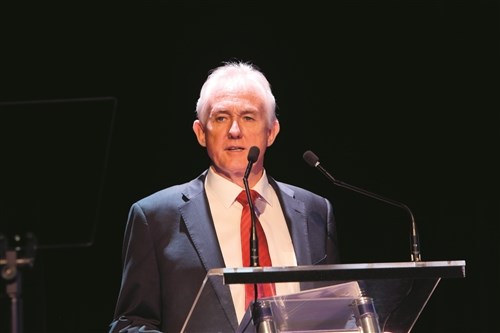 |
|
Retired operational chief of Isuzu Australia Phil Taylor was quick to recognise Harbison’s commercial instincts
|
NEW GENERATION
In a seamless handover several years in the making and in the immediate wake of Phil Taylor’s retirement, Andrew Harbison took the leap from sales and marketing director to director and chief operating officer of Isuzu Australia in February last year.
At ease in his surprisingly spartan office at Isuzu headquarters at Truganina in Melbourne’s windswept western rim, close to notching both his 50th birthday and 15 years with Isuzu, a reflective Harbison admits: “I’ve been incredibly blessed in my career.”
It has been, he adds with more than a hint of humility, a remarkable and largely unexpected journey since joining Isuzu in 2005 after a lengthy stint with a major tyre company before spending about 18 months with Holden in Queensland.
Back then, the car maker and the Japanese truck brand still operated as something of a corporate odd couple in a company called Isuzu-General Motors (I-GM) and as Harbison quips: “They were in the same office building, so moving from Holden to Isuzu at that time was little more than an internal transfer.
“I’d heard through office gossip about a vacancy at Isuzu and saw it as an opportunity to advance my career, so stuck my hand up,” he continues, conceding that he knew next to nothing about trucks or the trucking industry.
“I honestly thought I’d be moving to a sort of blue singlet, meat pie operation,” he says with a grin, “but was incredibly surprised to learn just how professional Isuzu, its people and the industry are. That surprised me, but the surprise only came from my own ignorance at the time.”
Interviewed for the role of Queensland sales manager by Taylor and Isuzu’s highly regarded former managing director, Yuki Murata, a candid Harbison says: “Phil’s passion for the industry was contagious. It made me want to be in the truck business.
“It was also the first time I’d had anything to do with the Japanese and Yuki impressed me from the start. Incredibly quiet but so insightful and intelligent. An incredible man with remarkable intuition.”
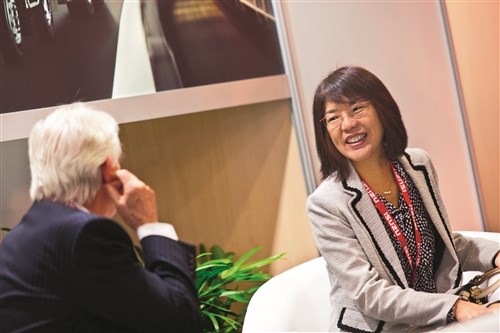 |
|
Isuzu Australia managing director and chief executive Hiroko Yaguchi gets the ear of former colleague Phil Taylor
|
As fate would have it, Harbison’s appointment came in the same year (2005) that Yuki Murata would play a critical role in the dissolution of I-GM and the formation of Isuzu Australia Ltd (IAL), freeing the Japanese brand from the rusted shackles of a decaying corporate monolith. “It was fortuitous, to say the least,” says Harbison.
Despite his somewhat passive demeanour, elevation through the executive ranks gave cause to Harbison’s underlying competitive streak and fervent aspirations for higher roles, fortifying Taylor’s faith in his protégé’s potential. In less than two years he’d moved to head office in Melbourne as national dealer sales manager, reporting directly to Taylor. Then came the national sales manager role and in 2016, obviously with the mutual anointment of Taylor and Japanese hierarchy, Harbison was appointed director of sales and marketing as his boss went higher up the ladder to chief operating officer.
Harbison doesn’t deny an ambitious trait. “In private meetings I would occasionally tell Phil I wanted his job, quite seriously,” he confesses.
“I was absolutely open about where I wanted to go in the company.
“Phil played his cards close to the chest about when he might retire but even so, things were starting to fall into place for an eventual transition.”
Asked if there were any concerns about following in Taylor’s deep footprints, a thoughtful Harbison replies: “The transition period was long enough for me to be comfortable with what I was required to do [but] Phil’s absence and input on a daily basis were something else. Every day we were talking about something, anything, and then comes the realisation your mentor is not there anymore.”
Fearful perhaps? “There is, I suppose, an underlying fear of sitting in the big chair of a very successful organisation like this and being able to maintain the energy and the success.”
Quiet for a few moments, an entirely serious Harbison remarks: “I would hate to be the one sitting in the chair if Isuzu ever lost market leadership. That would not be good.”
For some, both inside and outside the organisation, the big unknown was whether Harbison could mirror the assertive approach of his predecessor in dealing with difficult people and exceptionally aggressive market forces.
“Absolutely I can,” he fires back, “and that surprises some people, I think. It even surprises me at times. By nature I prefer being everybody’s mate but the hard decisions, especially the tough decisions with people, come with the role.
“In some respects, Phil and I are not as different as we may appear. We both came through the sales channel of the organisation and I certainly understand the sales environment and the process of getting a big deal across the line. But there’s far more to being market leader than that and we share an absolute passion for Isuzu and the industry we work in.”
Taylor’s greatest legacy, he contends, is a fierce determination to stick to proven principles and ensure that the product is the absolute best-fit for the Australian market, even if it meant ruffling Japanese feathers at times.
Does that suggest Harbison’s more subdued nature is better suited to dealing with the Japanese?
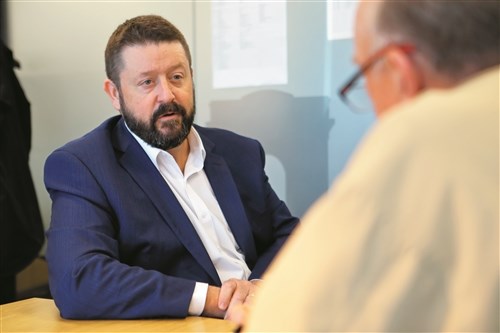 |
|
Flowing close under the Harbison skin lurks a hugely competitive character
|
“In some ways, it probably does,” he answered with a wry smile. “You can upset the Japanese very easily and that can be extremely difficult to reverse.”
On the other hand, “There are times when you need to be aggressive to get action on something and Phil was successful in that. He had a reputation for being fiery but from a product development point of view, he achieved a huge amount.
“I’ve had to step into that same role and whilst by nature I try to be conciliatory, some things need to be emphasised and we’ve had some fairly angry meetings up there [Japan].
“I keep pointing out that I’m here to protect the interests of the company down here and I will do everything I can to do that.”
The tenacity was clear and genuine, as was the desire to declare: “I go to every product meeting we have in Japan. It’s such a vital part of our business and I need and want to be part of it.”
However, recalling the highly effective relationship of Murata and Taylor, it’s a plainly sincere Harbison who cites current IAL managing director and chief executive officer Hiroko Yaguchi as a critical factor in providing the platform for the continuation of Isuzu Australia’s unrivalled success.
“I rate her very highly, and that’s not just being nice in a corporate sense,” he says with obvious regard for the woman who represents a tectonic shift in the somewhat staid, typically male traditions of Japanese companies.
“Yaguchi-san is the first female head of a distributor in the Isuzu world and if you were to ask, ‘What makes her good?’, the answer is that she can be incredibly forceful when she needs to be, has a memory like a bear trap, she is hugely intelligent, knows a lot of people in Japan at many levels, and has a great deal of emotional intelligence to understand the people around her.
“Don’t ever think you can pull the wool over her eyes. She is just so smart.”
Pausing for a few seconds, he continues: “I obviously report directly to her but it’s worth pointing out that Japan has a very good understanding of the need for the Australian operation to be run by Australians.
“Phil had a very clear mandate to run the organisation and that mandate has been passed to me.
“At the same time we have a strong but sometimes testing relationship with our parent company [Isuzu Motors Ltd], but again, they recognise that Australian management is why the company has been so successful here. We understand the market, the history of the company, the customer base, the dealer network and the direction the company needs to head.”
What’s more, it’s an earnest Harbison who insists IAL is fortunate to have a Japanese managing director with the corporate connections and executive smarts of Yaguchi “to manage the relationship between here and Japan, and leave the running of the company to local management”.
“She is incredibly effective,” he says with what is best described as a mix of genuine regard, relief and even gratitude.
COMPETITIVE INSTINCTS
Harbison’s first year in the high chair has been reasonable. As expected, Isuzu finished 2019 comfortably leading the light and medium-duty sectors, and holding its third place in the heavy-duty class despite a sizeable drop in sales.
Nonetheless, from the outside looking in, Isuzu’s overall market leadership can easily appear insurmountable and it’s a blunt Harbison who confirms that market domination remains the core focus of a company which has now notched 31 consecutive years of leadership.
“We’re driven by that,” he asserts, “and we will continually look for opportunities to add new product, adapt product to suit new markets, and continue to grow as an organisation to retain market leadership.
“This is absolutely what we are about and I think the example of our dual [steering] control model is a typical example of that. We identified the waste industry as a market we hadn’t traditionally done a lot of work in. It was primed for a new challenger to come in.”
Just as Isuzu did with its eight-wheeler in the agitator business? “Yes, very similar!”
Likewise, he confirms marketing will remain a major weapon in the Isuzu arsenal, traditionally spending bigger on promotion and campaigns than any other brand in the business.
As a smiling Harbison explains: “One of my very early mentors in life had a funny little poster in his office that read, ‘Doing business without advertising is like winking at a girl in the dark. You know what you’re doing but no one else does.’
“So the message is that you can have the very best product but without telling anybody about it, you’re keeping it in the dark.”
Yet for all Isuzu’s strengths and historical success, Harbison doesn’t shy from the existence of threats or weaknesses, perceived or otherwise, and insists no one in the company takes the competition for granted.
“This industry is way too competitive to allow yourself even a moment of arrogance or ignorance towards the competition.”
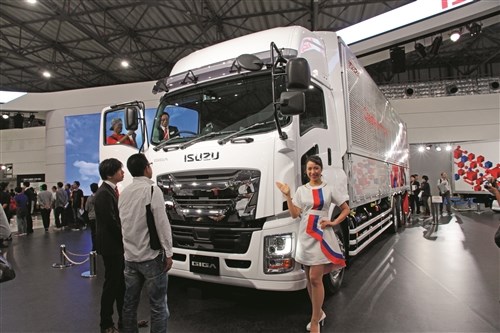 |
|
The new Isuzu Giga at last year’s Tokyo Motor Show. But impressive as it is, it won’t be coming to Australia unless there’s a Cummins underneath. For now, says Harbison, Japan is playing its cards close to the chest
|
Right now, however, there are worrying signs for the market leader. While an overall lead in 2019 of slightly more than 3,000 units over nearest rival Hino appears comfortable, it’s actually well down on the previous year’s performance when Isuzu was almost 4,400 units ahead of its arch challenger.
Without too much surprise, Hino has been quick to highlight its gains in 2019, citing an extensively revitalised range of 500-series medium-duty models equipped with an impressive list of standard safety features as a significant factor in gaining strong sales despite a softer market.
“Hino Australia has challenged industry trends,” states a recent Hino press release, “and despite tough market conditions, has become the only Japanese manufacturer to achieve positive sales results for the 2019 calendar year across all segments.”
In the medium-duty sector specifically “we saw impressive results which can be contributed to the all-new 500-Series Standard Cab, with Hino recording an overall market share of 31.6%, an increase of 5% versus 2018,” it says.
Isuzu, of course, isn’t blind to Hino’s improved performance last year, nor the fact that its own medium-duty numbers were more than 400 units (1.2 per cent) down on 2018’s figures.
Yet while it’s a candid Harbison who concedes that its major competitor has set the bar high in terms of medium-duty safety and picked up sales in the process, he is similarly intent on explaining that Isuzu has similar advances up its sleeve.
“We have been talking with our R&D team about the development of safety features for the past four or five years, so we are on a development timeline with those things,” he says.
As for when ‘those things’ might appear on the Australian market, the answer was a vague “In the near-ish future.
“From a competitive point of view I’d love to have them today, but at the same time I don’t want to see the product compromised by trying to rush something to market just to respond to what a competitor has done,” Harbison continues.
“Safety technology is constantly evolving and we’ve already had the option of taking some early systems, but we’ve opted not to do that. We don’t want to be a test bed for trialling early systems.”
However, as Hino’s strong sales suggest, much of the medium-duty market is looking for these safety features now.
“Absolutely it is,” Harbison agrees, “and like I said, we are on a development timeline that will see us with those features in the near-ish future.”
Whatever ‘near-ish’ means!
Determined to get the message across, a decidedly sanguine Harbison added: “I can’t control what our competitors do. I can only control what our response is [and] a big part of our product planning process is about taking feedback from the market and making sure we are providing the absolute best product we can.”
But on another tack, while its light-duty domination appears set in stone and medium-duty leadership remains solid despite obvious threats, can Isuzu hang on to its enviable third place in the ultra-crowded and intensely competitive heavy-duty sector where its numbers were also notably down in 2019?
Moreover, Isuzu’s hugely successful eight-wheeler will be soon targeted by an extremely impressive challenger from UD, while desires for a truly viable prime mover and heavy rigid contender to emerge from the 2018 announcement that Cummins and Isuzu are exploring ‘product sharing opportunities’ remain little more than wisps of hope on a distant horizon.
Despite the challenges, Harbison says Isuzu will be doing everything in its power to at least hold its current standing in the heavy-duty class.
As for the arrival of UD’s new eight-wheeler Quon and its targeted impact on Isuzu’s immense success in the concrete agitator business, he simply reiterated: “Again, I can’t control what our competitors do. I can only control what our response is.”
(Just a fortnight after this interview, Harbison was as shocked as anyone at the announcement of a ‘strategic alliance’ between Isuzu Motors and Volvo Group, which will see UD ownership transferred to Isuzu. See accompanying panel.)
It is, however, the absence of any news on progress of the Cummins initiative which continues to dampen IAL’s dreams of a serious shot at the heavy-duty leadership title it so blatantly covets.
Sure, the current Giga in the IAL range is a fundamentally honest, reliable truck but seriously outdated and under-equipped to be anything other than a token presence in the big end of the business. A realist, Harbison agrees.
“There’s clearly a big black hole in our heavy-duty model line-up,” he concedes.
In Japan, however, there’s an entirely new, stylish and highly advanced Giga now in operation. Yet while acknowledging the new model is “a far more impressive product” than the current offering, a definite Harbison states, “We won’t accept it in its current guise. We don’t want to compromise any future Giga programs by taking a product that’s not as good as we know it could be for our market.
“So much of our success has come from making sure we have the correct specification for our market. We cannot forget that. “
And it’s an astute Harbison who accepts that moving into the prime mover and heavy rigid classes puts Isuzu in an entirely new battleground where the contest is based almost exclusively on advanced US and European powertrains.
Still, given the lack of feedback from both Cummins and Isuzu since the announcement almost two years ago, does Andrew Harbison think a Cummins-powered Giga will actually happen?
“I certainly like to think it will,” he answers with a faint smile. “We could definitely do great things with it but honestly, Japan is playing this incredibly close to the chest.
“It’s a frustration to some degree because for us, it’s such an obvious part of the market that’s really going begging.”
Even so, and without the slightest hint of hubris, it was an assertive Harbison who concluded: “We’re number one in light duty, we’re number one in medium-duty and we’d love to be number one in heavy-duty.
“Why not? We’re good enough. All we need is the right product.”
